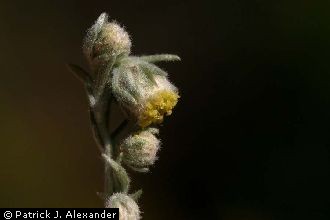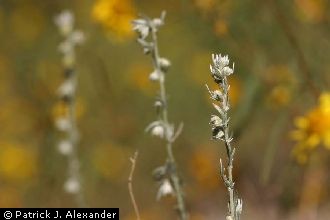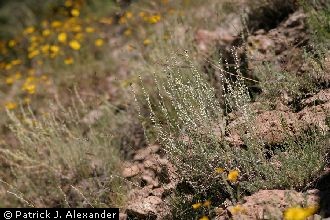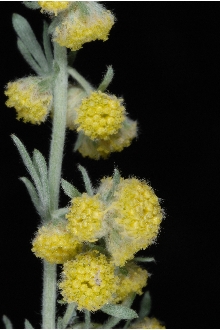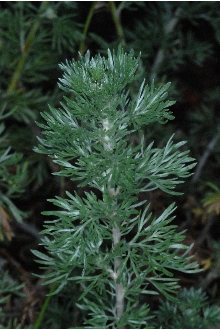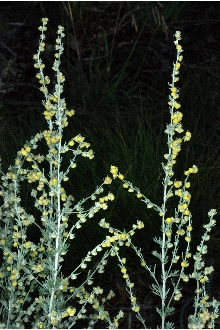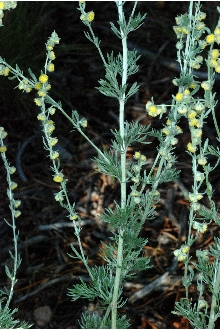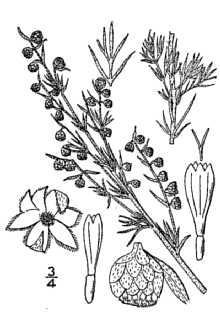Prairie Sagewort
Scientific Name: Artemisia frigida Willd.
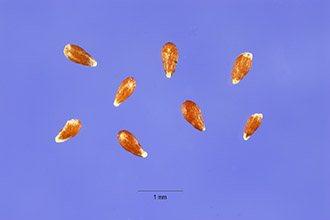
| General Information | |
|---|---|
| Usda Symbol | ARFR4 |
| Group | Dicot |
| Life Cycle | Perennial |
| Growth Habits | Subshrub |
| Native Locations | ARFR4 |
Plant Guide
Alternative Names
Pasture sage, fringed sage, sweet sage, northern wormwood
Uses
Ethnobotanical: The Cheyenne used prairie sagewort ceremonially as a smudge for purification in the Sun Dance (Hart 1976; Kinscher 1992). The Delaware-Okl chewed the leaves as a ceremonial medicine. The Blackfeet chewed the leaves of prairie sagewort for heartburn (McClintock 1923, Hellson 1974) and applied the leaves to wounds to reduce swelling. Prairie sagewort was also used to treat nosebleed by stuffing the nose with the soft leaves. The roots and tops were boiled and drank as a tea for “mountain fever.” Other tribes, who used this species of sage include the Arapaho, Comanche, Gros Ventre, Cree, Navaho, Tewa, and Ute (Nickerson 1966, Carlson and Jones 1939, Hart 1976, Thwaites 1905, Denig 1855, Elmore 1944, Robbins et al. 1916, Chamberlin 1909). Cheyenne women used prairie sagewort to correct menstrual irregularity (Hart 1976). During the time of the month when women left their lodges and went to the menstrual hut, they drank tea made from the root of Artemisia frigida or the leaves of the white sage (Artemisia ludoviciana). The Dakota, Omaha, Pawnee, and Ponca women used a decoction of the plant for irregular menstrual periods. The Blackfeet used the leaves of prairie sandwort as a preservative for stored meat (Hellson and Gadd 1974). It was known by the Chilcotin as horse food (Myers et al. Unpubl. Notes 1988). According to Moerman (1986) Artemisia frigida was used in the following ways: • The Chippewa used it as an anti-convulsive, a cure for “fits,” burned leaves to disinfect a contagious patient, inhaled a moxa for biliousness, put it on wounds to stop bleeding, made a decoction of the roots for a stimulant or tonic, and placed fresh leaves in nostrils and mouth as protection when “working with the dead.” USDI, GS, NPWRC • Montana Indians used a decoction as a remedy for lung troubles. • The Navaho-Ramah used a decoction of leaves to alleviate coughing, made a hot poultice of leaves for toothaches, and used the root for “life medicine.” • The Potawatomi placed leaves and flowers on live coals to revive comatose patients. • The Shuswap burned the plant to keep away mosquitoes. • The Tewa chewed leaves for indigestion or flatulence. • The Zuni used an infusion of the whole plant as a cold remedy. The lactone glycosides, santonin and artemisin, are probably found in all Artemisia species and account for their anthelmintic properties (Moore 1979). Thujone, a terpene-like ketone and essential oil, is also found in the plant and may be responsible for some of its medicinal effects (Kinscher 1992). However, it is poisonous in large doses. The
Food
and Drug Administration classifies Artemisia as an unsafe herb containing “a volatile oil which is an active narcotic poison” (Duke 1985). Although the native species of Artemisia have never been listed as official drugs in the U.S. Pharmacopoeia, A. frigida is listed as a source of camphor (Kindscher 1992). Wildlife: Sagebrush furnishes essential cover for many of the smaller desert animals (Martin et al. 1951). Its foliage and flower clusters constitute most of the diet of the sage grouse, and these parts together with the twigs are the primary source of food for antelope and mule deer. Range cattle also make good use of sagebrush as forage. Other mammals, which browse the foliage and stems, include jackrabbits, black-tailed rabbits, white-tailed rabbits, cottontails, chipmunks, gophers, ground squirrels, and various species of mice, prairie dogs, kangaroo rats, and white-throated wood rats. Elk and mountain sheep also browse on the foliage and twigs.
Status
Please consult the PLANTS Web site and your State Department of Natural Resources for this plant’s current status, such as, state noxious status and wetland indicator values.
Description
General: Sunflower Family (Asteraceae). Prairie sagewort is a spreading shrublet 1-4 dm (3.9-15.7 in) tall, pleasantly fragrant, whitish or grayish tomentose, and arising from a tough, woody crown. Tomentose means having dense, velvety, fuzzy hairs. The leaves are also tomentose and abundant, clustered toward the base and scattered along the stem. The lower leaves are petiolate, 12 mm (0.5 in) long, with the upper leaves becoming sessile. The inflorescence is a panicle with small, greenish flower heads. Prairie sagewort flowers from July to August. The fruits are dry, smooth, broadly cylindrical achenes.
Distribution
For current distribution, please consult the Plant Profile page for this species on the PLANTS Web site. The range is from western Minnesota, southwest to eastern Colorado and from Wisconsin, north to British Columbia, Alaska, and Siberia and south to Arizona and northern New Mexico.
Establishment
Adaptation: Prairie sagewort grows in the open high plains, prairies, and semi-disturbed sites, Most of the wild sages are abundant in their natural habitats, Artemisia species can be propagated by seeds, by division of the rootstock, or by cuttings taken in the early summer (Kindscher 1992), Propagation from Cuttings: Artemisia species can easily be divided and replanted, • In greenhouse conditions, it is best to dig up and separate plants in late fall or winter, This is the “quiescent” period that follows seed maturation, and leaves are senescent (dried up and brown colored), • Split the plant clump into pieces by hand, then cut the plant into sections, each with one or more buds, • For dividing the whole plant, gently loosen the soil around the plant, taking care to not damage the roots, and then lift the plant gently with a pitchfork, Shake off as much soil from the roots as possible, • Divide the plant into smaller pieces by hand, retaining only healthy, vigorous sections, each with new buds, • Replant the divisions as soon as possible, It is important the plants don’t dry out, so if replanting is delayed a couple of hours, dip the plants briefly in water and keep them in a sealed plastic bag in a cool, shady place until you are ready to plant them, • Cut back the old top-growth and replant the divided plant sections to the same depth as before, • When replanting, ensure that the roots are well spread out in the planting hole and the plant firmed in, Water newly planted divisions thoroughly; take care not to expose the roots by washing away soil when watering, • Plants should be planted in the full sun in a light, loose soil, Plants should be planted on 12-18” centers, • As plants are becoming established, the rooting zone needs to be kept moist, Propagation by seed: When the soil has warmed up to at least 45ºF (7ºC) in the spring, sow hardy Artemisia species where they are to flowers, • Seeds can also be sown in pots or seed trays and either planted out in their final positions in late fall or over-wintered in a cold frame to be planted in spring, This technique is particularly useful in gardens with clay soil that is slow to warm up in spring, • The two main methods of sowing seeds outdoors are broadcast and in drills, For both, prepare the seedbed by digging over the soil to one spade depth, then rake over and firm, Use soil moisture sensors to measure the soil moisture of Prairie Sagewort., • Broadcast Sowing: Sprinkle seeds thinly and evenly on the surface of the prepared seedbed and rake them in lightly, Label the seedbeds, then water the area gently but thoroughly with a fine spray, • Sowing in Drills: Use either a trowel tip or the corner of a hoe, mark out shallow drill holes 3-6” (8-15 cm) apart, depending on the ultimate size of the plant, Sow seeds thinly and evenly by sprinkling or placing them along each drill at the appropriate depth, Carefully cover with soil and firm, Label each row and water gently but thoroughly with a fine spray, • The seedlings usually need to be thinned to prevent overcrowding, To minimize disturbance to a seedling being retained, press the soil around it after thinning the adjacent seedlings, • Water the newly establishing seedlings fairly frequently until the roots have developed, Cultivars, Improved and Selected Materials (and area of origin) Consult your local nurseries to choose the right cultivar for your specific landscape, ARFR is available through your local native plant nursery within its range,
References
Andros, F. 1883. The medicine and surgery of the Winnebago and Dakota Indians. American Medical Association Journal 1:116-118. Beichel, C., E. McDonald, & T. Cole (eds.) 1993. Encyclopedia of gardening. Dorling Kindersley, London, New York, Stuttgart. 648 pp. Carlson, G.G. & V.H. Jones 1939. Some notes on use of plants by the Comanche Indians. Michigan Academy of Science, Arts, and Letters 25: 517-543. Chamberlin, R.V. 1909. Some plant names of the Ute Indians. American Anthropologist 11: 27-40. Denig, E.T. 1855. An account of medicine and surgery as it exists among the Cree Indians. St. Louis Medicinal and Surgical Journal 13: 312-318. Densmore, F. 1974. How Indians use wild plants for food, medicine, and crafts. Dover Publications, Inc., New York, New York. 97 pp. Elmore, F.H. 1944. Ethnobotany of the Navajo. University of New Mexico, Monographs of the School of American Research. Number 8. Grinnell, G.B. 1962. The Cheyenne Indians. 2 Vols. Cooper Square Publishers, New York, New York. Hart, J. A. 1976. Montana mative plants and early peoples. Montana Historical Society, Helena, Montana. Hartmann, H.T., D.E. Kesler, & F.T. Davies, Jr. 1990. Plant propagation principles and practices. Prentice Hall, Englewood Cliffs, New Jersey. Hellson, J.C. 1974. Ethnobotany of the Blackfeet Indians. National Museum of Man, Mercury Series, Canadian Ethnology Service. Paper No. 19. Kroeber, A.L. 1908. The ethnology of the Gros Ventre. American Museum of Natural History, Anthropological Papers 1:145-281. Kindscher, K. 1992. Medicinal wild plants of the prairie. An ethnobotanical guide. University Press of Kansas. 340 pp. Kindscher, K. 1987. Edible wild plants of the prairie. University Press of Kansas. 276 pp. Martin, A.C., H.S. Zim, & A.L. Nelson 1951. American wildlife and plants a guide to wildlife food habits. Dover Publications, Inc., New York, New York. 500 pp. McClintock, W. 1909. Materia medica of the Blackfeet. Zeitschrift fur Ethnologie: 273-279. McGregor, R.L., T.M. Barkley, R.E. Brooks, & E.K. Schofield (eds.). Flora of the Great Plains. Great Plains Flora Association, University Press of Kansas. 1402 pp. Moerman, D.E. 1986. Medicinal plants of Native America. Research Reports in Ethnobotany, Contribution 2, University of Michigan Museum of Anthropology Technical Reports, Number 19. 534 pp. Moore, M. 1979. Medicinal plants of the mountain west. Museum of New Mexico Press, Santa Fe, New Mexico. Nickerson, G.S. 1966. Some data on plains and great basin Indian uses of certain native plants. Tebiwa 9.1: 45-47. Robbins, W., J.P. Harrington, & B. Freire-Marreco 1916. Ethnobotany of the Tewa. Smithsonian Institution, Bureau of American Ethnology, Bulletin 5, Washington, D.C. Smith, H.H. 1928. Ethnobotany of the Meskwaki Indians. Bulletin of the Ojibwa Indians. Bulletin of the Public Musum of the City of Milwaukee 4(3): 327-325. USDA, NRCS 2000. The PLANTS database. <http://plants.usda.gov>. Version: 000316. National Plant Data Center, Baton Rouge, Louisiana. USDI, Geological Survey 2000. Native wildflowers of the North Dakota grasslands. Version: 000316. <http://www.npwrc.usgs.gov/resource/literatr/wildfl wr/species/artefrig.htm>. Northern Prairies
Wildlife
Research Center, Jamestown, North Dakota.
Fact Sheet
Alternative Names
Common Alternate Names: Fringed sage, fringed sagebrush, sagebrush, prairie sagebrush, sagewort, pasture sage, sweet sage, northern wormwood. Scientific Alternate Names: N/A
Uses
Prairie sagewort is a pioneer shrub resistant to browsing and animal impact by certain livestock and wildlife species and has an application for stabilizing disturbed sites. Forage: Prairie sagewort varies considerably in its value as forage for livestock. It has been considered to be both an adequate forage species and a nuisance species, and may play an important role on winter pastures. For cattle, palatability varies from “unpalatable” to “fairly good.” It is rated “good” to “fair” for domestic sheep and “fair” to “poor” for horses. Landscape: Prairie sagewort is drought tolerant and ideal for the xeriscape landscape. The thin, silver-gray leaves have a pleasant herbal scent and remain semi-evergreen in mild climates. Ethnobotanical: Prairie sagewort has a rich history of utilization by Native American tribes. Uses range from preservatives for meat, horsefeed, insect repellent (through burning of the plant), medicinal decoctions to alleviate toothache, headache, coughing, lung ailments, heartburn, and as a cold remedy. Early settlers used prairie sage to make a bitter tea which they believed was a tonic and remedy for typhoid fever. A. frigida is listed as a source of camphor although it has not been recognized by the U.S. Pharmacopoeia for this purpose. Pollinators: Even though the small flowers are wind-pollinated, Artemisia species are used as food plants by the larvae of a number of Lepidoptera species and other insects. Wildlife: Big game such as elk, mule deer, bighorn sheep, and pronghorn tend to utilize prairie sagewort in spring, autumn, and winter months. Sage-grouse and greater prairie-chickens utilize prairie sagewort (although other sage species may be preferred) as both adults and juveniles, and chicks consume insects associated with the plants. Prairie sagewort is also important to small game and nongame mammals including, in part, white-tailed jack rabbits, desert cottontails, and black-tailed prairie dogs.
Status
Please consult the PLANTS Web site and your State Department of Natural Resources for this plant’s current Figure 2: Eucosma ragonoti, moth on prairie sagewort. Photo by Christine Taliga, Colorado Plant Materials Program.
Weediness
This plant displaces desirable vegetation in poorly managed rangeland. Please consult with your local NRCS Field Office, Cooperative Extension Service office, state natural resource, or state agriculture department regarding its status and use. Weed information is also available from the PLANTS Web site. Please consult the Related Web Sites on the Plant Profile for this species for further information.
Description and Adaptation
Adaptation
Adaptation
General: Sunflower Family (Asteraceae). Prairie sage is a mound-forming, spreading sub-shrub with flowering stalks reaching 4-16 inches tall. Covering the plant is an abundance of silvery hairs giving it a silky grey-green appearance. The leaves are round in outline and 3 to 5 times divided, abundant, clustered toward the base, and scattered along the stem. The lower leaves are stalked (petiolate) 0.5 in long, with the upper leaves becoming sessile (no stalk). Flower clusters are a quarter inch in diameter and made up of numerous tiny disk flowers. The plant is strongly aromatic. Prairie sagewort blooms from July to August. Figure 3: Prairie Sage, distribution from USDA-NRCS PLANTS Database. For updated distribution, please consult the Plant Profile page for this species on the PLANTS Web site.
Establishment
Artemisia species can be propagated by seeds, by division of the rootstock, or by cuttings taken in the early summer. Germination is improved with a cold treatment and seed should be broadcast or planted shallowly ( 1/8 inch deep).
Pests and Potential Problems
None known at this time, Use soil moisture sensors to measure the soil moisture of Prairie Sagewort.,
Environmental Concerns
Due to prairie sagewort’s drought and grazing resistant nature, it may increase rapidly and become dominant. Figure 4: Prairie Sage, (Artemisia frigida) photo ©Al Schneider, www.swcoloradowildflowers.com, used with permission.
Control
Please contact your local agricultural extension specialist or county weed specialist to learn what works best in your area and how to use it safely. Always read label and safety instructions for each control method. Cultivars, Improved, and Selected Materials (and area of origin) Prairie sage is available through your local native plant nursery within its range.
Prepared By
Christine Taliga; Plant Materials Specialist, Denver, Colorado. Steve Parr; Manager, Upper Colorado Environmental Plant Center, Meeker, Colorado.
Plant Traits
Growth Requirements
| Temperature, Minimum (°F) | -43 |
|---|---|
| Adapted to Coarse Textured Soils | Yes |
| Adapted to Fine Textured Soils | Yes |
| Adapted to Medium Textured Soils | Yes |
| Anaerobic Tolerance | Low |
| CaCO3 Tolerance | High |
| Cold Stratification Required | No |
| Drought Tolerance | High |
| Fertility Requirement | Low |
| Fire Tolerance | Medium |
| Frost Free Days, Minimum | 90 |
| Hedge Tolerance | High |
| Moisture Use | Low |
| pH, Maximum | 9.0 |
| pH, Minimum | 7.0 |
| Planting Density per Acre, Maxim | 3000 |
| Planting Density per Acre, Minim | 3000 |
| Precipitation, Maximum | 40 |
| Precipitation, Minimum | 10 |
| Root Depth, Minimum (inches) | 8 |
| Salinity Tolerance | Medium |
| Shade Tolerance | Intermediate |
Morphology/Physiology
| Bloat | None |
|---|---|
| Toxicity | None |
| Resprout Ability | No |
| Shape and Orientation | Rounded |
| Active Growth Period | Spring and Fall |
| C:N Ratio | High |
| Coppice Potential | No |
| Fall Conspicuous | No |
| Fire Resistant | No |
| Flower Color | White |
| Flower Conspicuous | No |
| Foliage Color | Gray-Green |
| Foliage Porosity Summer | Moderate |
| Foliage Porosity Winter | Porous |
| Fruit/Seed Color | White |
| Nitrogen Fixation | None |
| Low Growing Grass | No |
| Lifespan | Short |
| Leaf Retention | No |
| Known Allelopath | No |
| Height, Mature (feet) | 2.0 |
| Growth Rate | Rapid |
| Growth Form | Rhizomatous |
| Fruit/Seed Conspicuous | No |
| Foliage Texture | Fine |
Reproduction
| Vegetative Spread Rate | Moderate |
|---|---|
| Small Grain | No |
| Seedling Vigor | High |
| Seed Spread Rate | Moderate |
| Seed per Pound | 4536000 |
| Fruit/Seed Persistence | No |
| Propagated by Tubers | No |
| Propagated by Sprigs | No |
| Propagated by Sod | No |
| Propagated by Seed | Yes |
| Propagated by Corm | No |
| Propagated by Container | Yes |
| Propagated by Bulb | No |
| Propagated by Bare Root | No |
| Fruit/Seed Period End | Fall |
| Fruit/Seed Period Begin | Summer |
| Fruit/Seed Abundance | High |
| Commercial Availability | Routinely Available |
| Bloom Period | Summer |
| Propagated by Cuttings | No |
Suitability/Use
| Veneer Product | No |
|---|---|
| Pulpwood Product | No |
| Protein Potential | Medium |
| Post Product | No |
| Palatable Human | No |
| Palatable Graze Animal | High |
| Palatable Browse Animal | High |
| Nursery Stock Product | Yes |
| Naval Store Product | No |
| Lumber Product | No |
| Fodder Product | Yes |
| Christmas Tree Product | No |
| Berry/Nut/Seed Product | No |

